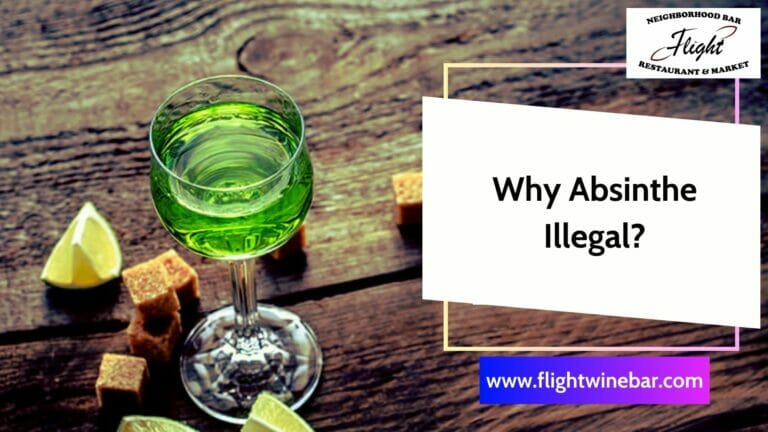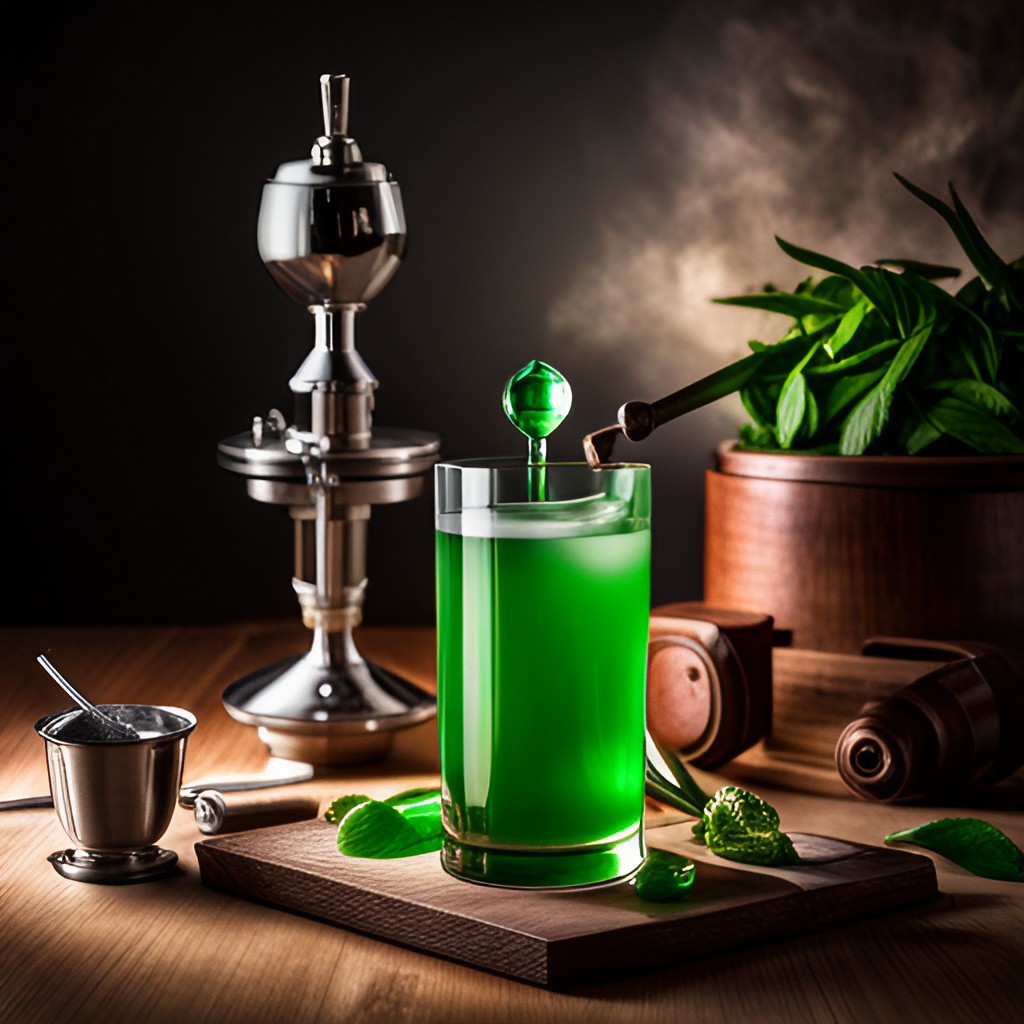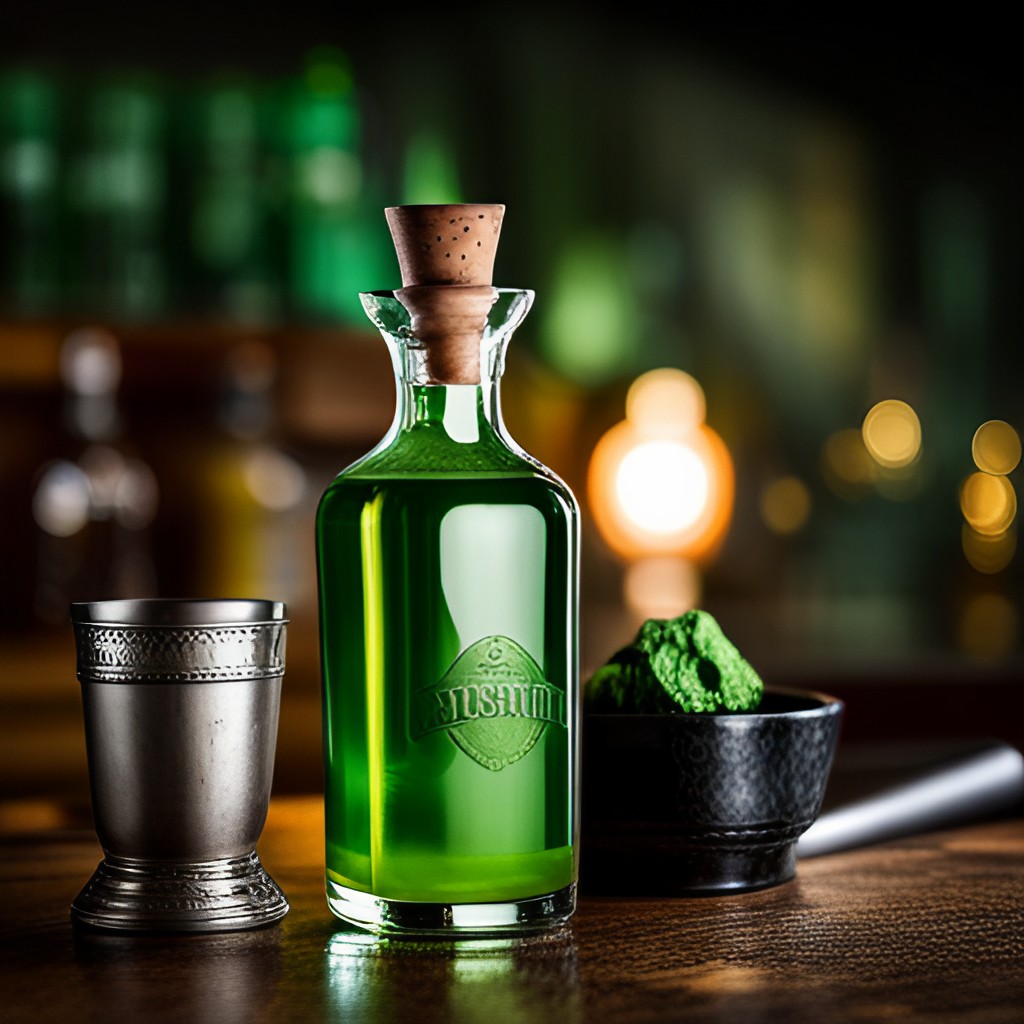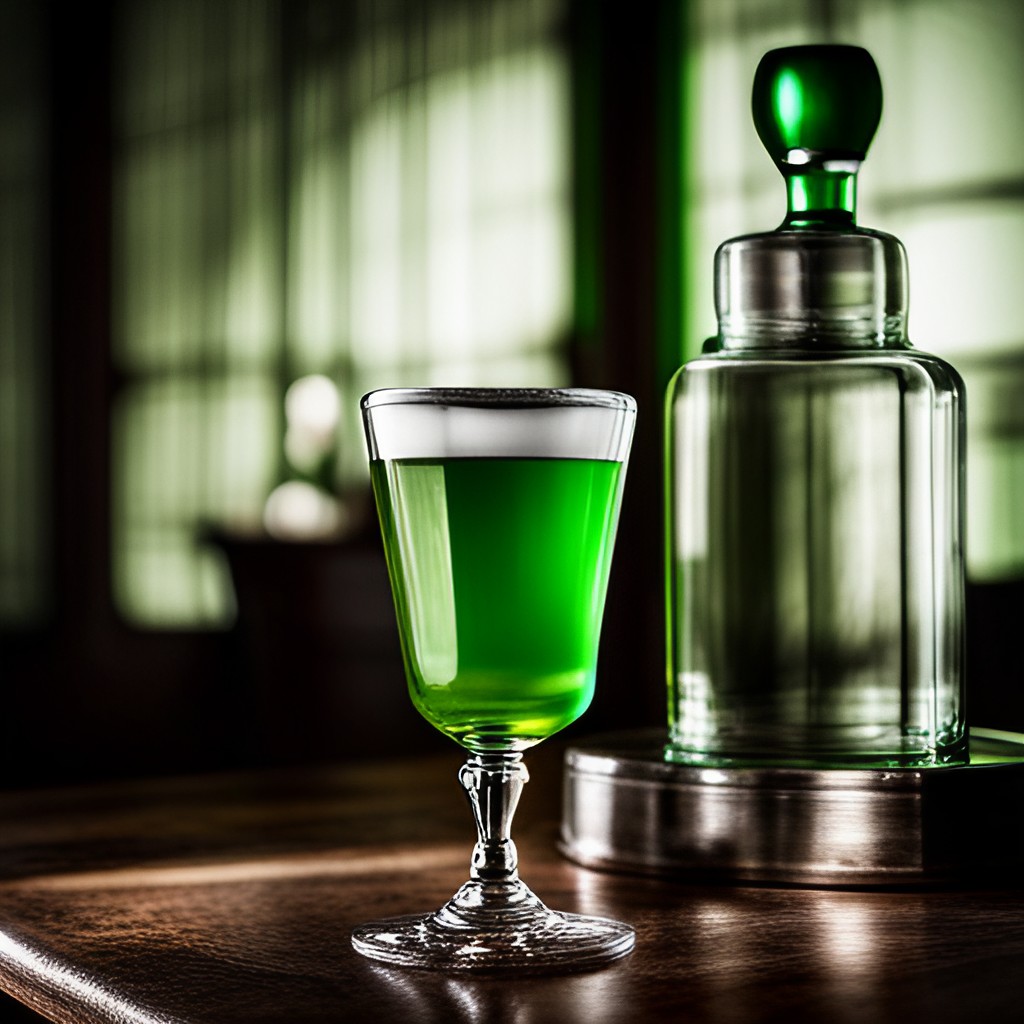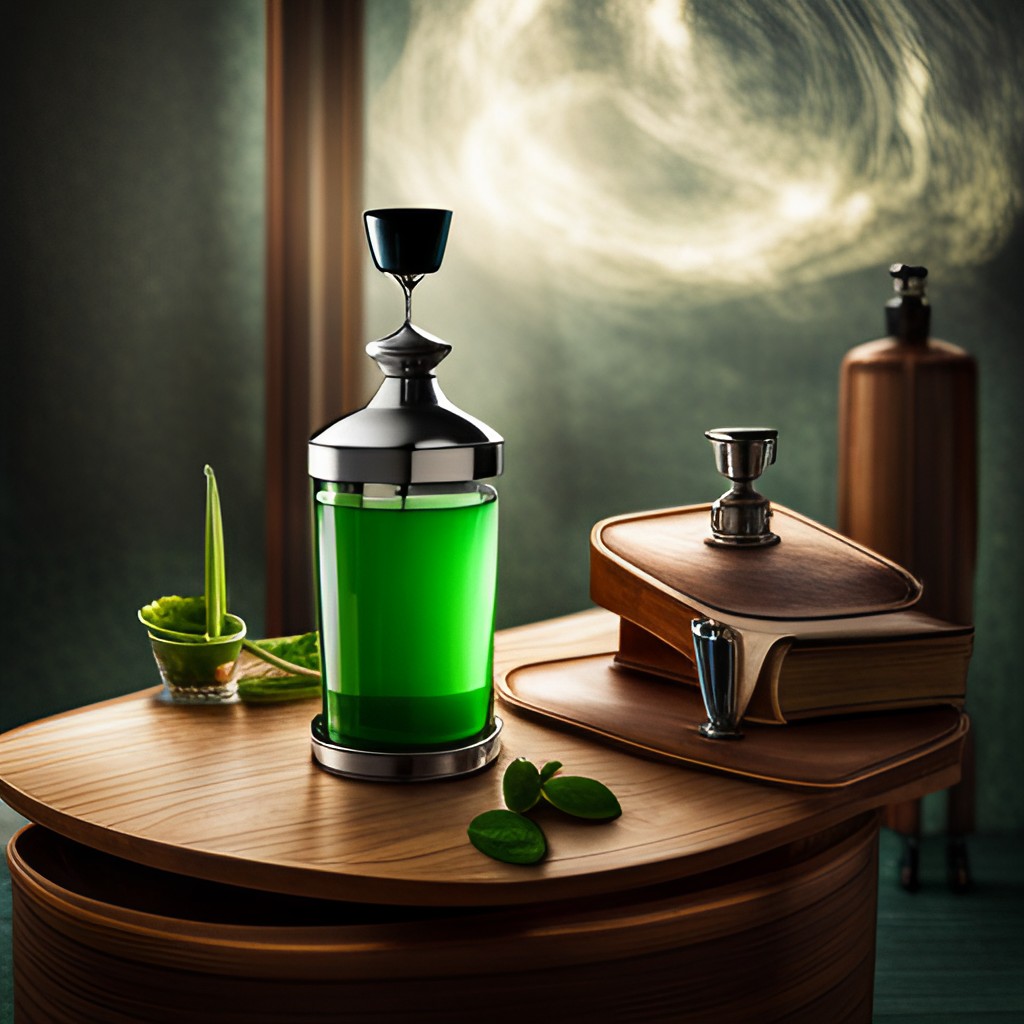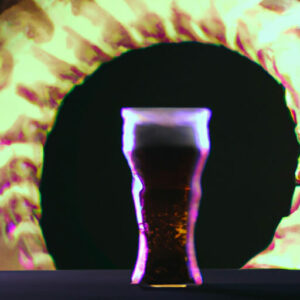Absinthe, a high-proof spirit with a rich and controversial history, has often been at the center of debates due to its supposed psychotropic properties. Its reputation as a hallucinogenic drink, sometimes referred to as the “Green Fairy,” has led to significant misunderstandings about its effects, ultimately resulting in its ban in numerous countries.
The question that often arises is “Why Absinthe Illegal?” This document will delve into the intricate history of absinthe, its controversial components, the myths surrounding its consumption, the legal battles it faced, and its current legal status worldwide. It aims to shed light on the reasons behind the prohibition of absinthe and provide a comprehensive understanding of the issues surrounding this enigmatic drink.
The History of Absinthe and Why it Became Illegal
Contents
- 1 The History of Absinthe and Why it Became Illegal
- 2 Why Absinthe Illegal?
- 3 The Dangers of Absinthe: A Look at its Health Risks and Banning
- 4 The Role of the Temperance Movement in Making Absinthe Illegal
- 5 The French Government’s Decisive Role in the Prohibition of Absinthe
- 6 The Swiss Government’s Impact on the Prohibition of Absinthe
- 7 The Role of the European Union in Making Absinthe Illegal
- 8 The Role of the United States in Making Absinthe Illegal
- 9 The Role of the Media in Making Absinthe Illegal
- 10 The Role of the Alcohol Industry in Making Absinthe Illegal
- 11 The Role of the Scientific Community in Making Absinthe Illegal
- 12 The Absinthe Ban Across the World
- 13 Current Legal Status of Absinthe Globally
- 14 Conclusion: Why Absinthe Illegal
- 15 FAQs about Why Absinthe Illegal
- 16 What is Absinthe?
- 17 What factors contributed to the infamous reputation of Absinthe?
- 18 What is Thujone and why is it controversial?
- 19 What is the relationship between Thujone and neurotoxicity?
- 20 What led to the ban of Absinthe in many countries?
- 21 Was the “Green Fairy” hallucination myth or reality?
- 22 What was the global impact of the absinthe ban?
- 23 How did Absinthe make a comeback in modern times?
- 24 What is the current legal status of Absinthe globally?
- 25 What led to changes in the legal status of Absinthe?
- 26 Does modern absinthe have the same composition as its historical counterpart?
- 27 Does Absinthe continue to be controversial today?
Discover the captivating world of absinthe – a timeless alcoholic beverage that has intrigued drinkers for centuries. Crafted using a secret blend of herbs, including wormwood, anise, and fennel, absinthe tantalizes with its vibrant greenish-yellow hue. Immerse yourself in the allure and mystery of this high-proof drink, known for its alcohol content ranging from 45 to 74 percent.
Originally conceived by Swiss doctor Pierre Ordinaire in the late 1700s, absinthe was believed to possess medicinal properties, offering relief from digestive issues and melancholy. Quickly embraced by the French, it found its place in cafes and bars, cultivating a loyal following among Parisian artists and literary luminaries like Ernest Hemingway and Oscar Wilde, forever intertwining its legacy with the bohemian spirit. Some even believed it to hold mystical hallucinogenic powers.
However, as the 20th century dawned, absinthe’s popularity waned. Temperance movements and unfounded fears regarding its supposed dangers contributed to its decline. In 1915, the United States instated a ban on absinthe, followed by other nations. The main motive behind the prohibition stemmed from the erroneous notion that absinthe contained the hallucinogenic compound thujone. Yet, modern research has debunked this myth, revealing absinthe’s harmless nature.
Despite its outlawed status in many countries, absinthe endures as a cherished elixir. Only a handful of states in the United States permit its consumption, but without thujone. Across Europe, various nations have legalized absinthe, albeit with strict regulations on thujone levels.
Absinthe’s rich and fascinating history persists, attracting a devoted following that appreciates its complexity and charm. While it may never regain its former glory, this remarkable libation continues to captivate and leave an indelible mark on the realm of alcohol.
Why Absinthe Illegal?
The legality of absinthe has historically been a contentious issue, primarily due to the presence of thujone, a chemical compound found in wormwood – one of the key ingredients in absinthe. Thujone was believed to have psychotropic properties and was associated with neurotoxicity, leading to severe mental and physical health concerns. These alleged harmful effects, combined with sensationalist media reports and moral panic, led to a widespread belief that absinthe induced hallucinations, violent behavior, and even insanity.
As a result, absinthe was banned in many countries, including the United States and much of Europe, in the early 20th century. However, recent scientific research questions the extent of thujone’s effects and its concentration in absinthe, leading to a reappraisal of the drink’s safety and a lift on the ban in some places. Nevertheless, the controversy surrounding thujone and absinthe’s tumultuous history continue to influence its legal status worldwide.
The Dangers of Absinthe: A Look at its Health Risks and Banning
Discover the unsettling truth about absinthe, the highly alcoholic beverage that took Europe by storm in the late 18th century. Crafted from a blend of herbs like wormwood, anise, and fennel, this potent drink, often enjoyed with water and sugar, packs a punch with alcohol levels ranging from 45 to 75 percent.
While absinthe had its heyday among creative types in the 19th century, it also carried significant health risks that couldn’t be ignored. This led to its prohibition in numerous countries during the early 20th century.
The chief concern with absinthe lies in its exceptionally high alcohol content. Excessive consumption can have dire consequences, such as liver damage, heart disease, and even stroke. Furthermore, absinthe contains thujone, a compound derived from wormwood known to induce hallucinations and mental health issues.
Beyond the health risks, absinthe has also been associated with social problems. During the 19th century, it was linked with criminal behavior and violence, sparking concerns over public safety. Consequently, it was banned in countries like the United States and the United Kingdom.
Although absinthe remains prohibited in certain nations, it is legal in many others. Nevertheless, it must be emphasized that absinthe is a potent alcoholic beverage that warrants moderation. With knowledge of its potential health risks, it is crucial to seek medical counsel if any adverse effects arise.
The Role of the Temperance Movement in Making Absinthe Illegal
The temperance movement significantly contributed to the worldwide prohibition of absinthe. Originating in the early 19th century in the United States, this social movement aimed to reduce or eliminate alcohol consumption and attained global reach, including France, where absinthe enjoyed popularity.
Arguing that alcohol was a main catalyst for social issues such as poverty, crime, and family disintegration, the temperance movement advocated for a healthier and more morally upright society by reducing or eradicating alcohol consumption. Specifically targeting absinthe, they contended that its production involving wormwood (containing a chemical called thujone) was exceptionally dangerous. Thujone was believed to be a hallucinogen, causing mental illness and addiction. Consequently, the temperance movement advocated for the complete ban of absinthe, persuasively arguing that it posed a greater threat than other alcoholic beverages.
The temperance movement achieved significant success in their endeavor to prohibit absinthe. The United States implemented the ban in 1905, followed by France in 1915. Other nations soon followed suit, resulting in absinthe becoming illegal in most of Europe by the mid-1920s.
Undoubtedly, the temperance movement played a pivotal role in the prohibition of absinthe. Their compelling arguments regarding its dangers resonated with governments, leading to the successful prohibition of the beverage. Consequently, absinthe remains illegal in numerous countries even today.
The French Government’s Decisive Role in the Prohibition of Absinthe
Absinthe, a once beloved alcoholic beverage in 19th century France, met a stark fate when the French government intervened in 1915, rendering it illegal. Facing a decline in popularity and growing concerns about alcoholism and societal issues linked to absinthe, the French government swiftly acted by passing a law making the substance illegal.
The law stemmed from the findings of a scientific commission, specifically tasked with investigating the effects of absinthe. After careful evaluation, the commission classified absinthe as a dangerous and addictive substance posing serious health risks. Moreover, links were established between absinthe and social problems, such as crime and violence. Consequently, the French government made the conscious decision to censure both the sale and consumption of absinthe.
The police were enlisted to enforce the ban, conducting raids on locations suspected of selling absinthe. Public sentiment overwhelmingly supported the prohibition, viewing absinthe as a perilous and morally corrupting substance. Although the ban was eventually lifted in 1988, strict regulations on the production and sale of absinthe continue to be upheld by the French government.
To sum up, the French government played a pivotal role in the prohibition of absinthe in 1915. Responding to diminishing popularity and the conclusive findings of a scientific commission, they swiftly passed legislation to outlaw the sale and consumption of absinthe. The ban was diligently enforced by the police and bolstered by public support – a ban that still remains in effect today.
The Swiss Government’s Impact on the Prohibition of Absinthe
In order to address growing concerns about the potential health risks associated with absinthe, the Swiss government took decisive action. In 1905, a law was passed that outright banned the sale and production of this popular alcoholic beverage.
Absinthe, made from a mix of herbs including wormwood, anise, and fennel, had enjoyed popularity in Switzerland during the late 19th and early 20th centuries. However, reports of its potential health hazards sparked a decline in its consumption.
The Swiss government, worried about the possible dangers of absinthe, believed it could lead to hallucinations, convulsions, and even mental illness. Furthermore, it was feared that absinthe had addictive properties that could contribute to alcoholism.
To combat these worries, the Swiss government implemented strict enforcement measures with the help of the Swiss Federal Council. Additionally, a public awareness campaign was launched, utilizing posters, pamphlets, and newspaper articles to educate the population about the potential health risks associated with absinthe consumption.
These efforts proved successful, as by 1910, absinthe had been fully prohibited in Switzerland. This ban has remained in place ever since, with absinthe still illegal in Switzerland today.
The Role of the European Union in Making Absinthe Illegal
The European Union (EU) has been instrumental in prohibiting the production and consumption of absinthe in multiple countries. Absinthe, a strong alcoholic drink made from various herbs, was once a popular and fashionable choice in Europe. However, its association with alcoholism, violence, and mental illness prompted public outrage and demands for a ban.
Taking action in 1905, the EU implemented a law across all member states that strictly banned the sale and consumption of absinthe. This legislation was based on the belief that absinthe posed significant dangers and held addictive properties. In 1988, the EU further reinforced this ban with a directive that extended the prohibition throughout its member states.
The success of the EU’s ban on absinthe is undeniable. Today, absinthe is illegal in the majority of EU countries, and its availability is scarce in other parts of the world. Consequently, the absinthe industry has been greatly impacted as producers struggle to sell their products.
In summary, the European Union has played a pivotal role in prohibiting absinthe in numerous countries, achieving considerable success in curbing its production and consumption.
The Role of the United States in Making Absinthe Illegal
Discover the U.S.’s pivotal role in the prohibition of absinthe during the early 20th century. Absinthe, an alcoholic beverage made from a blend of herbs including wormwood, gained popularity in Europe, particularly in France and Switzerland. Known for its potent anise flavor and high alcohol content (ranging from 45 to 75 percent), the green fairy held a special allure for the bohemian lifestyle of the era.
However, absinthe was not without its controversies. Reports of alarming health complications, including hallucinations, seizures, and even death, prompted action. In 1912, the United States banned absinthe following a campaign led by the Anti-Saloon League. This influential organization argued vehemently that absinthe was an addictive and dangerous substance, posing a significant threat to public health and safety. The American Medical Association echoed these concerns, labeling absinthe a “dangerous and insidious poison.”
This movement against absinthe was further supported by the temperance movement, which saw the beverage as a gateway to alcoholism. Absinthe was condemned as a “demon drink” thought to foster addiction and contribute to social ills.
Although the ban was lifted in 2007 due to subsequent research debunking initial claims of its dangers, strict regulations pertaining to the production and sale of absinthe remain in place within the United States. Notably, some states still uphold the ban, meaning that absinthe remains illegal in those regions.
In summary, the United States wielded substantial influence in the prohibition of absinthe during the early 20th century. Key supporters of the ban included the temperance movement and the American Medical Association, both of whom argued that absinthe possessed addictive and hazardous properties. While the ban was eventually overturned, regulations and restrictions surrounding the production and sale of absinthe persist in the United States to this day.
The Role of the Media in Making Absinthe Illegal
Absinthe, a once popular alcoholic beverage across Europe in the 19th century, faced a dramatic turnaround in the early 20th century due to the media’s portrayal. Sensationalized reports spread false claims about its effects, branding it as a dangerous and addictive substance responsible for hallucinations, insanity, and even death. Despite the lack of scientific evidence, the media succeeded in shaping public perception and instilling fear around absinthe.
Newspapers and magazines further fueled the hysteria by extensively covering stories of absinthe-related dangers, including tragic deaths. This continuous coverage intensified the public’s anxiety towards the drink and worsened the overall perception.
In their quest to ban absinthe entirely, the media actively campaigned and pressured governments to take action. Editorials were published and campaigns organized to push for criminalization. The media’s relentless efforts ultimately led to the enactment of bans on absinthe in numerous countries.
In summary, the media played a pivotal role in the prohibition of absinthe during the early 20th century. With their sensationalized reports, emphasis on the drink’s dangers, and lobbying efforts, the media successfully cultivated an atmosphere of fear and hysteria around absinthe, eventually leading to its criminalization.
The Role of the Alcohol Industry in Making Absinthe Illegal
The prohibition of absinthe was a complex decision, and the alcohol industry played a significant role in its outcome. During the late 19th century, absinthe gained popularity throughout Europe, particularly in France. This herbal-based drink, containing wormwood, was believed to have hallucinogenic effects, sparking concerns regarding safety and potential abuse.
Simultaneously, the alcohol industry was experiencing rapid growth and became apprehensive of absinthe’s competition. Brewery and wine producers actively lobbied governments, asserting that the drink was dangerous and addictive, ultimately leading to its ban.
In 1905, the French government responded to these concerns, prohibiting absinthe. Following suit, other European countries, including Switzerland, where absinthe originated, also implemented bans.
The alcohol industry’s influence extended into the United States. In 1912, the US government enacted the Pure Food and Drug Act, which included a provision that outlawed the sale of absinthe. This decision was heavily influenced by pressure from the alcohol industry, motivated by the threat of competition.
While the ban on absinthe was eventually lifted in numerous countries during the late 20th century, it is imperative to acknowledge the pivotal role the alcohol industry played in the drink’s prohibition. Their lobbying efforts were a significant contributing factor in the bans implemented throughout various nations.
The Role of the Scientific Community in Making Absinthe Illegal
The scientific community played a pivotal role in the global prohibition of absinthe, a potent alcoholic beverage made from various herbs. This drink, which gained popularity in Europe during the late 19th and early 20th centuries, was subjected to scrutiny by scientists who uncovered numerous health risks associated with its consumption.
In the late 19th century, researchers in France and Switzerland conducted studies that highlighted the potential dangers of absinthe. These studies revealed that absinthe had the capacity to induce hallucinations, seizures, and even fatality. This critical information was widely disseminated by the scientific community, igniting a call to ban absinthe altogether.
One of the factors that contributed to absinthe’s reputation as a hazardous drink was its high alcohol content and the presence of thujone, a chemical found in the herb wormwood. Thujone was believed to be a neurotoxin that accentuated the negative health effects associated with absinthe, including hallucinations.
Paying heed to the scientific community’s findings, governments across the globe took action. Many countries implemented bans on absinthe, with the United States prohibiting it in 1912 and France following suit in 1915.
The scientific community’s comprehensive warnings regarding the potential health risks posed by absinthe were instrumental in the international prohibition of this once-popular beverage. Governments were convincingly persuaded by the scientific evidence, prompting them to protect their citizens from the potential dangers lurking in each glass of absinthe.
The Absinthe Ban Across the World
The absinthe ban was not confined to a single region, but rather was a movement that spanned continents in the early 20th century. In the United States, the ban was instituted in 1912 amid rising concerns about its alleged detrimental effects on mental health. The prohibition in France, where absinthe had become a cultural symbol, was even more dramatic. It was banned in 1915 following a notorious criminal case known as the “Absinthe Murder,” which stoked public fears about absinthe-induced insanity.
A similar narrative unfolded across much of Europe, with countries like Belgium and Switzerland imposing bans. The dominos continued to fall until absinthe was virtually erased from the global market. However, the ban was not universal. In some regions, such as Spain and the United Kingdom, absinthe never faced full prohibition, allowing a thread of the absinthe tradition to survive during the global ban era. Today, the legal status of absinthe remains a patchwork of national regulations, reflecting both the drink’s tumultuous history and its enduring mystique.
Current Legal Status of Absinthe Globally
The legal status of absinthe today is a complex and varied picture, reflecting the spirit’s contentious history. In the European Union, regulations established in 1988 permit the production and sale of absinthe, provided its thujone content does not exceed 10 milligrams per kilogram. France, once a stronghold of anti-absinthe sentiment, lifted its ban in 2011, although the term “absinthe” itself remains legally protected. In Switzerland, the birthplace of absinthe, the prohibition was officially lifted in 2005, marking the end of nearly a century of illicit “La Bleue” home distillation.
The United States followed suit in 2007, allowing the sale of absinthe that meets specific thujone content requirements. However, some countries, such as Canada, have complex regulations that vary by province. Despite the relaxation of laws in many regions, a handful of countries, including Samoa and Malaysia, maintain a complete ban on absinthe. Thus, while the “Green Fairy” has been welcomed back in many parts of the world, it still dances in a legal gray area in others.
Conclusion: Why Absinthe Illegal
While the absinthe ban was put in place for good reasons, it is now widely believed among experts that there may be some misconceptions about the risks of consuming absinthe. In recent years, scientific studies have shed light on its effects, and researchers have delved into its historical context to get a more accurate understanding. Answers still remain elusive in regards to why absinthe illegal, and further research is likely needed before a definitive answer can be found.
Furthermore, numerous nations are slowly beginning to repeal the bans on absinthe as they come to realize that perhaps it shouldn’t be classified as an inherently harmful substance. As society advances with time and knowledge, trends are often reevaluated and redefined. As a result, while the prohibition of absinthe still stands in certain countries today, only time will tell if these restrictions will persist or if this drink will one day again become widely available.
FAQs about Why Absinthe Illegal
What is Absinthe?
Absinthe is a high-proof distilled spirit, often characterized by its distinctive green color and anise flavor. Originating in Switzerland in the late 18th century, it became highly popular among artists and writers in France in the 19th and early 20th centuries.
What factors contributed to the infamous reputation of Absinthe?
The infamous reputation of absinthe was largely a result of sensationalist media reports and public fears driven by its supposed psychotropic properties. Its high alcohol content and the alleged effects of thujone, a component of wormwood, contributed to its reputation as a mind-altering substance.
What is Thujone and why is it controversial?
Thujone is a chemical compound found in several plants, including wormwood, which is a key ingredient in absinthe. It was believed to have psychotropic properties and was associated with neurotoxicity, making it the focal point of controversy surrounding absinthe.
What is the relationship between Thujone and neurotoxicity?
Historical beliefs suggested that thujone was neurotoxic and could lead to a range of health issues including hallucinations and mental disorders. However, modern scientific research has called these assertions into question.
What led to the ban of Absinthe in many countries?
The perceived harmful effects of thujone, along with sensationalist media portrayal and societal concerns about absinthe’s high alcohol content and potential to cause violent behavior and insanity, led to its ban in many countries, including the United States and most of Europe.
Was the “Green Fairy” hallucination myth or reality?
The “Green Fairy” hallucination is more myth than reality. While absinthe was widely believed to cause hallucinations, modern scientific research suggests that its hallucinogenic properties were greatly exaggerated.
What was the global impact of the absinthe ban?
The absinthe ban significantly impacted distilleries worldwide, leading to the drink’s disappearance for almost a century in many regions. Its prohibition also marked a shift in societal attitudes towards alcoholic beverages.
How did Absinthe make a comeback in modern times?
The resurgence of absinthe in modern times can be attributed to a better understanding of its effects and the lifting of bans in several countries. Additionally, there has been a renewed interest in historical and artisanal spirits.
What is the current legal status of Absinthe globally?
The legal status of absinthe varies globally. While it is still banned in some countries, many others have lifted their bans, allowing for its production and sale with specific regulations in place regarding thujone content.
What led to changes in the legal status of Absinthe?
Changes in the legal status of absinthe have largely been driven by scientific research disproving many of the harmful effects initially associated with the drink, along with changes in societal attitudes and a resurgence of interest in absinthe.
Does modern absinthe have the same composition as its historical counterpart?
Modern absinthe can differ significantly from its historical counterpart, especially in terms of thujone content. Today, many countries regulate the amount of thujone allowed in absinthe, often resulting in lower concentrations than in the past.
Does Absinthe continue to be controversial today?
Despite its comeback and the debunking of many myths, absinthe continues to be a subject of controversy. Its historical reputation, combined with its high alcohol content and unique flavor profile, continue to attract debate and intrigue.

